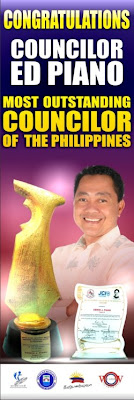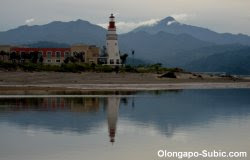GMA: No limit to Subic
By Anthony Deleon, Central Luzon Bureau
The $215-million Subic port rehabilitation project broke ground on Thursday with President Arroyo expressing confidence on the “limitless potential” of Subic as the new container-transport hub in Central Luzon.
“I see no limit to the potentials of the Subic Freeport as a container-transport hub. With strategic location and its port facilities, Subic promises to be a major regional hub for port operations,” Mrs. Arroyo said in a message, which was read by Senior Deputy Executive Secretary Joaquin Lagonera.
In her message, the President urged the Subic Bay Metropolitan Authority (SBMA) “not to lose its momentum in making Subic a regional container terminal, an industrial hub, a tourism haven and a cultural and information technology center, all rolled into one.”
In response to the President’s call, Chairman Felicito C. Payumo of the SBMA assured the Subic port development project will be the major portal of the new Global Gateway, an alliance between the Subic Freeport and the Clark Zone that will benefit not only Central Luzon but the entire country as well.
Payumo added that the project involves the construction of new modern container port through the special yen loan assistance granted by the Japan Bank for International Cooperation (JBIC).
“With the construction of this new container port, we shall partake not only of this trade but of the predicted capacity shortage estimated at 40 million tons,” Payumo said, noting that the Subic port will become the alternative port to decongest the metropolis.
Furthermore, he said the project would enable the port of Subic to increase its cargo-handling capacity from the present 53,000 to 600,000. The first berth with a capacity of 300,000 tons will be finished by 2005-2007 and the second berth in 2009.
Meanwhile, Minister Akio Egawa, Japan’s deputy chief of mission, said his country is grateful for the opportunity to strengthen ties between the Philippines and Japan through the port development project.
“We are now even more pleased that through the Subic Bay Port Development Project, we have an opportunity to further strengthen our special relationship,” Akio said.
Last month, Penta Ocean Corp., with its partners Shimitsu Corp. and TOA Corp. has been awarded the port modernization project after successfully passing the comprehensive evaluation conducted by the Bids and Awards Committee (BAC).
The committee noted that Penta Ocean group submitted the lowest financial tender of P5.22 billion, which was about 25-percent lower than BAC’s estimate of P6.99 billion, or up to P1.77 billion in savings for the project. Toyo Corp. offered P5.59 billion or about P360-million higher than the winning bid.
The bidding was conducted in the presence of representatives of the Commission on Audit, members of the Press, the Subic Bay Chamber of Commerce, and the SBMA to ensure transparency
The $215-million Subic port rehabilitation project broke ground on Thursday with President Arroyo expressing confidence on the “limitless potential” of Subic as the new container-transport hub in Central Luzon.
“I see no limit to the potentials of the Subic Freeport as a container-transport hub. With strategic location and its port facilities, Subic promises to be a major regional hub for port operations,” Mrs. Arroyo said in a message, which was read by Senior Deputy Executive Secretary Joaquin Lagonera.
In her message, the President urged the Subic Bay Metropolitan Authority (SBMA) “not to lose its momentum in making Subic a regional container terminal, an industrial hub, a tourism haven and a cultural and information technology center, all rolled into one.”
In response to the President’s call, Chairman Felicito C. Payumo of the SBMA assured the Subic port development project will be the major portal of the new Global Gateway, an alliance between the Subic Freeport and the Clark Zone that will benefit not only Central Luzon but the entire country as well.
Payumo added that the project involves the construction of new modern container port through the special yen loan assistance granted by the Japan Bank for International Cooperation (JBIC).
“With the construction of this new container port, we shall partake not only of this trade but of the predicted capacity shortage estimated at 40 million tons,” Payumo said, noting that the Subic port will become the alternative port to decongest the metropolis.
Furthermore, he said the project would enable the port of Subic to increase its cargo-handling capacity from the present 53,000 to 600,000. The first berth with a capacity of 300,000 tons will be finished by 2005-2007 and the second berth in 2009.
Meanwhile, Minister Akio Egawa, Japan’s deputy chief of mission, said his country is grateful for the opportunity to strengthen ties between the Philippines and Japan through the port development project.
“We are now even more pleased that through the Subic Bay Port Development Project, we have an opportunity to further strengthen our special relationship,” Akio said.
Last month, Penta Ocean Corp., with its partners Shimitsu Corp. and TOA Corp. has been awarded the port modernization project after successfully passing the comprehensive evaluation conducted by the Bids and Awards Committee (BAC).
The committee noted that Penta Ocean group submitted the lowest financial tender of P5.22 billion, which was about 25-percent lower than BAC’s estimate of P6.99 billion, or up to P1.77 billion in savings for the project. Toyo Corp. offered P5.59 billion or about P360-million higher than the winning bid.
The bidding was conducted in the presence of representatives of the Commission on Audit, members of the Press, the Subic Bay Chamber of Commerce, and the SBMA to ensure transparency






